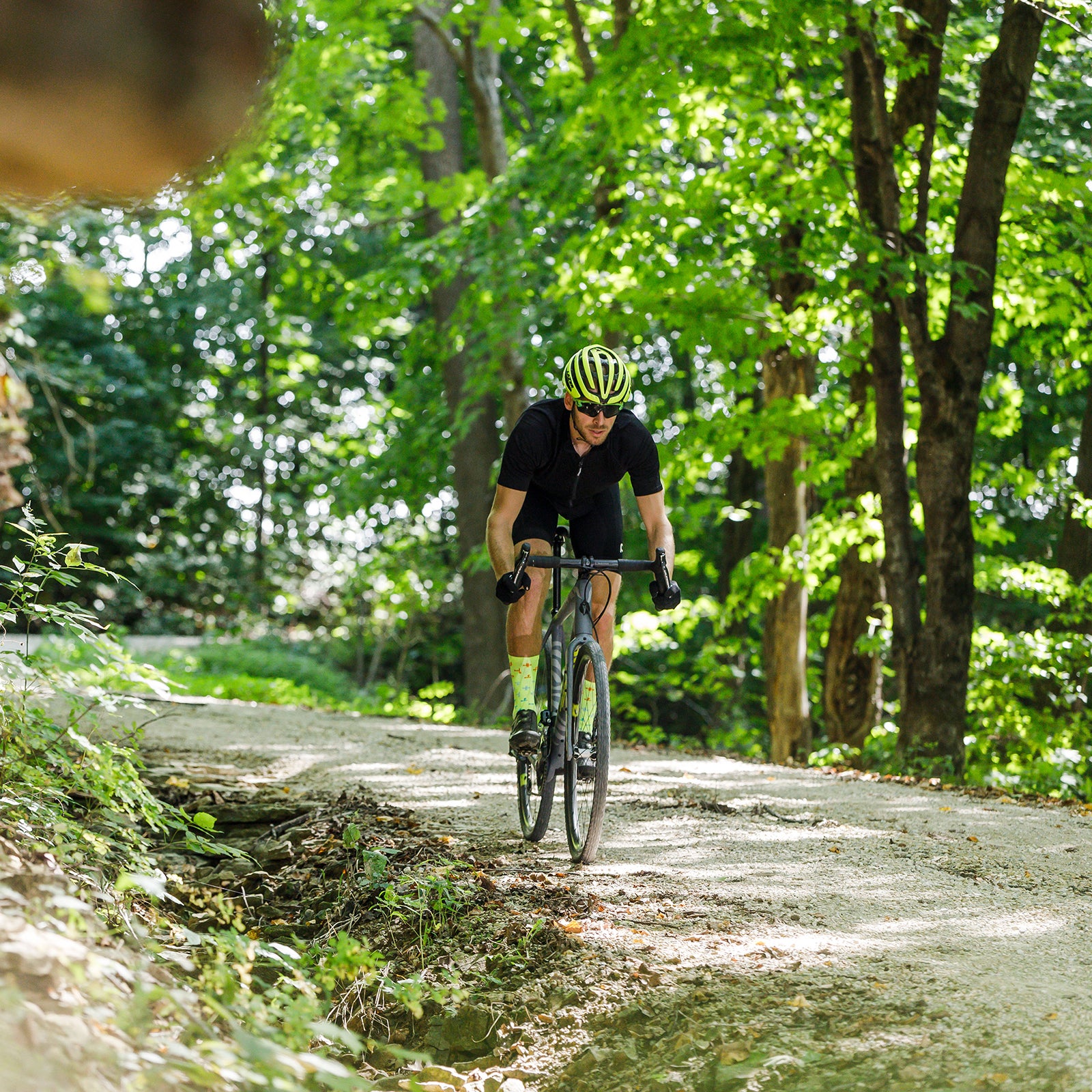Gravel riding is the hot item in cycling right now. Races╠řlike and are selling out in minutes, and companies are scrambling to introduce new products for the category. The niche has actually been around for over a decade (and much longer╠řif you use a broad definition of riding drop-bar bikes off pavement), but only recently has it started to be a thing.╠řWhy? In a word: equipment.
Gravel gear as a category is just a baby. production gravel-race bikes, SalsaÔÇÖs Warbird, is only eight years old. The races that created it, midwestern farm- and forest-road rambles like the , , and Almanzo 100, date back to the mid-2000s. The fact that road and even cyclocross bikes werenÔÇÖt really up to terrain challenges, like Trans IowaÔÇÖs peanut-butter mud or the KanzaÔÇÖs tire-shredding Flint Hills, led Salsa to create the Warbird.
In the decade since, gravel has exploded into one of the industryÔÇÖs success stories. More importantly, from that early Warbird and a few crucial parts, like tires from Donnelly and WTB, the bike industry created a massive change in the variety of products that are available╠řand the philosophies of the companies that make them. And most vital of all, that shift is not limited to gravel bikes. The changes the genre kicked off are making all drop-bar bikes better, whatever surface you ride╠řon.
The bike industry has proved adept╠řat addressing narrow slices of the market with purpose-built gear. Often those nichesÔÇösinglespeeds! fat bikes! aero road machines!ÔÇödouble as the trend of the moment, and the industry eagerly jumps on them in an attempt to re-create the heady boom years of mountain biking. So gearmakers, first the╠řsmall ones and then the big ones close behind, responded quickly to gravelÔÇÖs rise.
But the genius of gravelÔÇöwhat separates it from previous fads and makes it so consequential to cycling gear in generalÔÇöis that itÔÇÖs not any one thing. Yes, gravel is races like the Kanza and Grinduro. But itÔÇÖs also long-distance bikepacking and ╠řrides. ItÔÇÖs big-adventure rides. ItÔÇÖs the person╠řwho puts slightly fatter tires on his road bike to escape SoCal traffic via╠řfire roads╠řor to link out-and-back canyon roads╠řfor a loop in ColoradoÔÇÖs Front Range. In short, itÔÇÖs anything you do on drop-bar bikes on unpaved terrain.
That breadth forced the industry to do something it hadnÔÇÖt done since mountain bikes: build for different experiences. Especially since the growing availability of carbon-fiber technology in the early 1990s, the bike industryÔÇÖs approach to design and marketing╠ř(especially for drop-bar bikes) has been driven primarily by racing. This philosophical value framework, with competition at its center, focused on performance attributes like light weight, aerodynamics, and stiff frames for more efficient power transfer, all of which came at the expense of comfort, durability, and versatility.
A number of companies realized that this race-centric approach didnÔÇÖt satisfy all riders, but they didnÔÇÖt know how to respond. In 2004, just a few years before the gravel boom, a number of companies were to make comfort-oriented road bikes, like the original Specialized Roubaix, which featured vibration-damping materials and slightly wider tires. But those efforts were still narrowly focused on pavement, which meant they were simultaneously a bit sluggish for spirited road riding and also not really dirt capable. As a bike tester who regularly ventured off pavement, I found them unsatisfying. I couldnÔÇÖt convey why or what I was searching for, only that this wasnÔÇÖt it.╠ř
Early gravel riders articulated what I couldnÔÇÖt: they wanted bikes that steered confidently in fast, loose descents; that fit bigger tires and still had room to shed mud; and that came with frame mounts for enough bottle cages and accessory bags to go on long, remote rides where resupply or a quick bailout wasnÔÇÖt possible. By the early 2010s, a╠řfew small, smart companies with a history of making unconventional bikes,╠řlike Salsa,╠řtook on the risk of designing for those riders. The original Warbird had a longer wheelbase, slacker head angle, and lower bottom bracket than road or cyclocross╠řterrain. It also had more mud clearance and disc brakes, a rarity at the time for drop-bar bikes. Other╠řsmall brands, like Kona and Niner, followed.
By 2015 or so, when the industry at large finally grasped what riders wantedÔÇöand that the old design values didnÔÇÖt totally apply anymoreÔÇöit╠řacted fast. A prime example is tires. At the time,╠řthe only natural-surface tires╠řthat would work on drop-bar bikes were for cycloross, and those were rarely wider than 35 millimeters, thanks to . But gravel riders went everywhere from farm tracks to singletrack, in everything from mud to moon dust. They wanted wider tires and different treads╠řand didnÔÇÖt give a damn about stodgy rules for other disciplines. Tire makers responded with diverse options. You can get╠řa 30-millimeter-wide, lightly treaded knobby with a fast-rolling center for a mix of pavement and light dirt, a 50-millimeter monster-truck knobby not far short of a mountain-bike tire, and everything in between. Pavement-only bikes benefited from the changes, too. We used to hunt for road slicks as fat as 25 millimeters. Now theyÔÇÖre available in up to╠ř38 millimeters, with╠řframe dimensions nudged out to accommodate larger rubber.
With the freedom and new experiences made possible by better equipment, cycling is accessible to a whole host of people who might otherwise have felt unwelcome.
Bigger tires donÔÇÖt just make bikes more versatile; they make them more comfortable. Larger tire volume means lower proportional pressure, which blunts the buzz and jolts from rough pavement or dirt washboards. To a point, bigger-volume tires at lower pressure also have less rolling resistance. Riding is more fun and still almost as fast.
The second significant shift: gearing. Ten years ago, youÔÇÖd struggle to find a road drivetrain with gears lower than a 34-tooth chainring and 28-tooth cog. That seems low enough,╠řbut not for the steeper climbs you find on unpaved terrain. Consider that╠řan efficient pedal cadence typically ranges from about 75 to 100 rotations per minute (rpm). Unless youÔÇÖre an inveterate gear grinder, dropping below 70 rpm for long periods of time feels awful. But on a climb with a 10 percent grade, a mythically average 165-pound rider on an 18-pound bike must sustain 280 watts to spin that 34-by-28 low gear at a cadence of 75 rpm. ThatÔÇÖs a threshold-power output attainable only by trained amateur racers.╠ř
For years╠řgeneral thinking was that a component that was ideal for a 29-year-old category 3 racer was good enough for everyone else. The success of early gravel bikes like the Warbird helped the industry realize that was not the case. Today╠řyou can find gravel-specific single- and double-chainring drivetrains from companies like Shimano and SRAM in almost any combination you want, with low gears that enable far more comfortable cadences on steep climbs.
WhatÔÇÖs more, these changes in both tires and drivetrains have spread beyond gravel. Even pro road racers today than they used to for steep mountain stages at races like the Giro dÔÇÖItalia, largely because theyÔÇÖre available.╠řAnd to the industryÔÇÖs credit, itÔÇÖs also expanded those options across full product lines. Even the most affordable road and gravel bikes (starting at around $1,000) now feature wider tiresÔÇöor at least frame clearance for themÔÇöand broad-range gearing with lower small gears.
Yes, you can still find purpose-built aero road machines, though even those have more generous tire clearance than they did just five years ago. But youÔÇÖll also find road bikes designed for a wide array of riding experiences, not just racing. Trek, for instance, has both the aero , for pure pavement performance, and the , a lightweight race bike.╠řBut instead of making the Emonda a pavement-specific machine for racers as it wouldÔÇÖve done even five years ago, Trek willfully took a small weight penalty to sensibly outfit it╠řwith a 34-by-28 low gear that can handle up to 30-millimeter rubber for modest dirt capability. Want more unpaved adventure? Try the brandÔÇÖs pavement-plus , with a 34-by-34 low gear and 32-millimeter tires (and╠řclearance for 38ÔÇÖs). If you need something more rugged still, thereÔÇÖs the gravel-and-adventure , with clearance for 45-millimeter tires and accessory mounts for fenders, extra water bottles, frame bags, and other add-ons for long races and bikepacking.
Big brands arenÔÇÖt the only ones offering that kind of choice. Boutique frame maker Allied Cycle Works, for example, offers the , a hardcore road bike that accepts up to a 28-millimeter tire for some dirt adventures; the sprightly pavement-plus , which fits tires up to 35 millimeters to get a little more rowdy; and the , a full-on gravel model with all the fixings. You get to pick the gearing range on each. And of course thereÔÇÖs Salsa, with the latest , the , and five other models, in various component builds, for all kinds of adventures.
ThereÔÇÖs always the chance that gravel is simply another fad that will recede, that the bike-industry pendulum will swing back to narrow tires and race-oriented builds, and that dwindling gravel devotees will hoard╠řwide tires and cassettes.
But I doubt it. In five years, gravel racing may be the obstacle-course racing of bikes: still a fun scene, albeit not the same juggernaut it is today. But my suspicion is that gravel riding will grow, and the changes itÔÇÖs producing in the bike industry will stick around. ThatÔÇÖs because the biggest shift isnÔÇÖt a single product.
With the freedom and new experiences made possible by better equipment, cycling is accessible to a whole host of people who might otherwise have felt unwelcome. The low gearing thatÔÇÖs ideal for bikepacking the Continental Divide Trail is also perfect for novice and recreational riders who want to climb comfortably. The rugged tires and wheels that help see a racer through the Dirty Kanza without a flat or broken rim are also ideal for riders whose bodies donÔÇÖt fit the thin racer stereotype and look dimly on equipment that comes with a rider weight limit. Hydraulic disc brakes, which gravel helped popularize for drop-bar bikes, make for more confident descending on pavement or dirt, regardless of skill level. And overall, the shift away from suffering as virtue and toward╠řfun, exploration, and enjoyment of nature╠řmight be what sets us all free to enjoy cycling at our own pace.╠řWhatever kind of riding you want to do, and wherever you want to go, thereÔÇÖs finally a bike for that.


